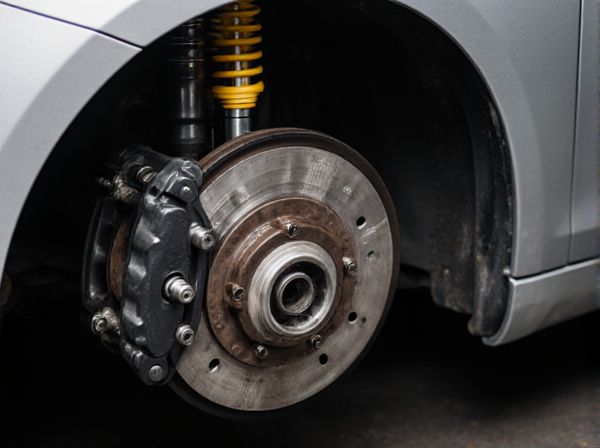
Photo illustration: Torque Vectoring vs Locking
Torque vectoring enhances your vehicle's handling by actively distributing power between wheels to improve traction and stability, especially during cornering. Locking differentials, on the other hand, force both wheels on an axle to rotate at the same speed, providing maximum traction in off-road or slippery conditions but reducing maneuverability. Understanding the differences helps optimize your vehicle's performance based on driving needs and terrain.
Table of Comparison
| Feature | Torque Vectoring | Locking Differential |
|---|---|---|
| Function | Distributes torque between wheels for optimal traction and handling | Locks both wheels on an axle to rotate at the same speed |
| Performance | Enhances cornering stability and reduces understeer | Improves traction in off-road or low-grip conditions |
| Usage | Common in high-performance and AWD vehicles | Typical in off-road and heavy-duty applications |
| Control | Electronically or hydraulically controlled for dynamic adjustment | Manually or automatically engaged, fixed locking state |
| Cost | Higher due to advanced technology and sensors | Lower, simpler mechanical design |
| Effect on Tire Wear | Minimizes uneven tire wear by adjusting torque | Can cause increased tire wear due to locked wheels |
| Driving Conditions | Optimal for variable traction and sporty driving | Best for challenging terrains with wheel slip |
Introduction to Torque Vectoring and Locking
Torque vectoring enhances vehicle stability and cornering by selectively distributing torque between wheels based on traction needs, improving handling and performance. Locking differentials mechanically force both wheels on an axle to rotate at the same speed, providing maximum traction in low-grip situations but reducing maneuverability on turns. Understanding the differences between torque vectoring and locking systems is essential for optimizing traction control and driving dynamics in various road and off-road conditions.
How Torque Vectoring Works
Torque vectoring enhances vehicle stability and cornering by actively distributing engine power between wheels on the same axle, using sensors and electronic controls to detect wheel slip and steering input. Unlike locking differentials that mechanically force equal wheel rotation, torque vectoring selectively increases torque to the outer wheel during a turn, improving grip and reducing understeer. This dynamic power allocation maximizes traction and performance in various driving conditions by optimizing wheel torque in real-time.
Understanding Locking Differentials
Locking differentials mechanically force both wheels on an axle to rotate at the same speed, enhancing traction in off-road or slippery conditions by preventing wheel spin. Unlike torque vectoring systems that actively distribute torque based on sensor inputs and driving dynamics, locking differentials provide a simple, robust solution for maintaining power delivery. This mechanical lock improves grip but can reduce maneuverability on dry pavement due to the lack of differential action.
Key Differences Between Torque Vectoring and Locking
Torque vectoring enhances vehicle stability and cornering by actively distributing power between wheels based on driving conditions, improving traction and handling. Locking differentials mechanically force two wheels on an axle to rotate at the same speed, primarily providing maximum traction in low-traction environments. Unlike locking, which can cause understeer on turn, torque vectoring offers dynamic power adjustments, resulting in smoother, more responsive vehicle control.
Performance Impact: On-Road vs Off-Road
Torque vectoring enhances on-road performance by precisely distributing power between wheels, improving cornering stability and traction on paved surfaces. Locking differentials excel off-road by forcing equal torque to both wheels on an axle, maximizing grip in low-traction conditions like mud or rocks but can cause understeer and tire wear on roads. The choice between torque vectoring and locking differentials significantly impacts vehicle handling dynamics, with torque vectoring favoring agile on-road driving and locking differentials prioritizing robust off-road capability.
Advantages of Torque Vectoring Systems
Torque vectoring systems enhance vehicle stability and handling by independently distributing power to each wheel based on real-time driving conditions, improving cornering performance and traction. These systems enable precise control during acceleration and deceleration, reducing understeer and oversteer compared to traditional locking differentials. Enhanced responsiveness and safety in dynamic driving environments make torque vectoring a superior choice for performance and all-wheel-drive vehicles.
Benefits of Locking Differentials
Locking differentials provide superior traction by mechanically connecting both wheels on an axle, ensuring equal power distribution even when one wheel loses grip. This feature enhances off-road performance and stability on uneven or slippery terrains, preventing wheel spin and enabling controlled movement. Compared to torque vectoring, locking differentials offer a simpler, more robust solution for maintaining momentum in challenging driving conditions.
Common Applications and Use Cases
Torque vectoring is commonly applied in high-performance sports cars and all-wheel-drive SUVs to enhance cornering stability and improve traction by distributing torque variably between wheels. Locking differentials are typically used in off-road vehicles and heavy-duty trucks to provide maximum traction on uneven or slippery terrain by mechanically forcing wheels to rotate at the same speed. Both technologies optimize drivetrain performance, with torque vectoring favoring on-road handling and locking differentials prioritizing off-road capability.
Maintenance and Reliability Considerations
Torque vectoring systems require regular software updates and sensor calibration to maintain optimal performance and reliability, while locking differentials rely on mechanical components that may need periodic lubrication and inspection for wear. Torque vectoring's complexity can lead to higher repair costs and diagnostic challenges compared to the simpler, more robust design of locking differentials. Maintenance of locking differentials typically involves fewer electronic components, reducing the risk of electronic failures and enhancing long-term reliability under harsh driving conditions.
Choosing the Right System for Your Vehicle
Choosing the right system for your vehicle depends on your driving needs and terrain, as torque vectoring enhances cornering stability by independently controlling power to each wheel, offering superior handling on winding roads. Locking differentials provide maximum traction by mechanically linking wheels on an axle, making them ideal for off-road or low-traction conditions. Evaluating factors such as driving style, road conditions, and vehicle application helps determine whether the dynamic control of torque vectoring or the brute-force traction of locking differentials suits your vehicle best.
 caratoz.com
caratoz.com